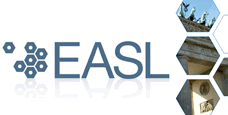 Starting
around 2000 clinicians began reporting outbreaks of apparently
sexually transmitted hepatitis C
virus (HCV) infection among HIV
positive gay and bisexual men in the U.K., followed by large
cities in Europe, Australia, and North America. HIV/HCV
coinfected people tend to experience more rapid liver disease
progression and do not respond as well to interferon-based
therapy, but treatment is more effective if started during
acute HCV infection.
Starting
around 2000 clinicians began reporting outbreaks of apparently
sexually transmitted hepatitis C
virus (HCV) infection among HIV
positive gay and bisexual men in the U.K., followed by large
cities in Europe, Australia, and North America. HIV/HCV
coinfected people tend to experience more rapid liver disease
progression and do not respond as well to interferon-based
therapy, but treatment is more effective if started during
acute HCV infection.
Three
posters presented at the European Association for the Study
of the Liver's International Liver Congress (EASL
2011) this month in Berlin looked at sexually transmitted
HCV in men with HIV.
HCV
Incidence in CASACDE
Investigators with the CASCADE Collaboration characterized the
hepatitis C epidemic among HIV positive men who have sex with
men (MSM) from 1990 through 2007. Recent phylogenetic analyses
suggest that the spread of HCV in this population started around
1996, they noted as background.
The researchers estimated HCV incidence among HIV positive MSM
in 12 cohorts in the U.K., Europe, and Canada participating
in the CASCADE study. They accounted for the fact that HCV data
collection started in different years in the various cohorts.
Of 4724 MSM in the participating cohorts, 3014 men with an available
HCV test result were included in the analysis. Of these, 124
men (4%) had only positive HCV test results, 2798 (93%) had
only negative results, and 92 (3%) had both.
In 1990 HCV incidence ranged from 0.9 to 2.2 cases per 1000
person-years (PY), depending on the method of analysis used.
HCV incidence crept up through 1995, when it was estimated at
between 5.5 and 8.1 per 1000 PY. From 2002 onwards, new HCV
infections increased more substantially, reaching estimated
incidence rates ranging from 16.8 to 30.0 cases per 1000 PY
in 2005 and 23.4 to 51.1 cases per 1000 PY in 2007.
"Our data support phylodynamic findings that HCV incidence
had already increased among HIV-infected MSM from the mid-1990s,"
the researchers concluded. "However, the main expansion
of the HCV epidemic started after 2002."
"Raising awareness, routine testing, and HCV treatment
are needed to minimize further spread of HCV among HIV-infected
MSM," they recommended.
Treating
Acute HCV
In a related study, P. Ingiliz and colleagues performed a retrospective
analysis of more than 300 HIV positive men in northern Germany
who were diagnosed with acute HCV infection between 2001 and
2008. The researchers compared untreated patients vs those who
received interferon-based therapy.
Most study participants (93%) reported male-male sex as a risk
factor for HCV infection; only 3 people (1%) reported injection
drug use. The median age at HCV diagnosis was 40 years (range
20-69 years). A majority (70%) had HCV genotype 1 while 18%
had genotype 4, which is uncommon in Europe outside MSM sexual
transmission clusters. The men had well-controlled HIV overall;
the median duration of HIV infection was 5.5 years, median HIV
viral load was 110 copies/mL, and median CD4 cell count was
461 cells/mm3.
About three-quarters of participants received hepatitis C therapy,
with a median treatment duration of 33 weeks. Just over half
of patients who completed treatment and follow-up achieved sustained
virological response (SVR). Men who achieved SVR were treated
significantly longer than non-responders (41 weeks vs 27 weeks).
About one-quarter of the untreated participants spontaneously
cleared HCV.
"Our findings confirm that acute hepatitis C in HIV-infected
patients affects mainly MSM who acquire HCV sexually,"
the researchers concluded. "In this real-life setting from
urban regions in northern Germany, treatment rates appear to
be high."
HCV
Reinfection
Finally, J. Sasadeusz and colleagues from the U.K. and Australia
looked at rates of apparently sexually transmitted HCV re-infection
among HIV positive MSM after interferon-based therapy.
Using a clinical database, the researchers identified new cases
of acute HCV infection that occurred between March 2003 and
December 2007. They looked at spontaneous HCV clearance, treatment
response, and re-infection rates. Re-infection was defined as
detectable HCV RNA following treatment-induced SVR or 2 consecutive
undetectable tests at least 3 months apart following spontaneous
clearance.
A total of 61 people -- all men -- met the case definition for
acute HCV infection; 97% reported male-male sex as a risk factor.
Here too, about 73% had HCV genotype 1 and 20% had genotype
4.
Within this group, 9 men (15%) experience spontaneous HCV clearance
and 40 were treated with pegylated interferon plus weight-based
ribavirin. The SVR rate was high at 80%.
Of the 41 men with either spontaneous clearance or SVR, 39%
subsequently experienced re-infection (including 1 man who was
re-infected twice). HCV re-infection occurred a median 46 months
(range 20-66 months) after initial infection, and all had male-male
sex as their reported risk factor. Only 1 re-infected patient
experienced spontaneous HCV clearance, 9 underwent treatment
again, and 33% achieved SVR.
Based on these findings, the researchers concluded, "HCV
infection remains high in HIV positive MSM individuals."
"There is no immunity conferred by prior infection,"
they added. "There is a need to alter high-risk behaviors
leading to re-infection."
These results are in accordance with those of another
recent analysis reported at this year's Retrovirus conference
(CROI 2011), which found that 25% of HIV positive men treated
for acute hepatitis C in Amsterdam became re-infected within
about 1 year.
Investigator affiliations:
Abstract 1053: Cluster Infectious Diseases, Health Service Amsterdam;
Department of Internal Medicine, Center for Immunity and Infection
Amsterdam (CINIMA), Academic Medical Center, University of Amsterdam,
Amsterdam, Netherlands; Instituto de Salud Carlos III, Madrid,
Spain; Basel Institute for Clinical Epidemiology & Biostatistics,
University Hospital Basel, Basel, Switzerland; INSERM U897,
University Victor Ségalen, Bordeaux, France; Instituto
Superiore di Sanitá, Rome, Italy; Department of Medicine,
University of Calgary, Calgary, Alberta, Canada; Robert Koch
Institute, Berlin, Germany; Oslo University Hospital, Ulleval,
Norway; MRC Clinical Trials Unit, London, UK; Department of
Clinical Epidemiology, Biostatistics and Bioinformatics, Academic
Medical Center, University of Amsterdam, Amsterdam, Netherlands.
Abstract 243: Medical Center for Infectious Diseases, Infectious
Diseases, Vivantes Auguste-Viktoria Klinikum, Berlin, Germany;
Medical Center for Infectious Diseases, Hamburg, Germany;MVZ
City Ost, Praxiszentrum-Kaiserdamm Dres. Jörg Gölz
Arend Moll, Praxis Hintsche-Klausen, Praxis Tumstrasse, Praxis
Koeppe/Kreckel, Berlin, Germany; Center for Interdisciplinary
Medicine, Muenster, Germany; Aerzteforum Seestrasse, Berlin,
Germany.
Abstract 1057: Alfred Hospital, Melbourne, Victoria, Australia;
Infection and Population Health, University College London,
UK; Infectious Diseases/HIV Medicine, Royal Free Hospital, London,
UK.
4/23/11
References
J
van der Helm, M Prins, J del Amo, et al (CASCADE Collaboration).
The hepatitis C epidemic among HIV-positive men who have sex
with men: incidence estimates from 1990 to 2007. 46th Annual
Meeting of the European Association for the Study of the Liver
(EASL 2011). Berlin. March 30-April 3. Abstract
1053.
P
Ingiliz, M Obemeier, L Weitner, et al. Acute hepatitis C in
persons infected with the human immunodeficiency virus (HIV):
the "real-life setting" proves the concept. 46th Annual
Meeting of the European Association for the Study of the Liver
(EASL 2011). Berlin. March 30-April 3. Abstract
243.
J
Sasadeusz, A Rodger, T Fernandez, and S Bhagani. High rates
of sexually transmitted HCV re-infection in HIV positive men
who have sex with men: prevention is the key. 46th Annual Meeting
of the European Association for the Study of the Liver (EASL
2011). Berlin. March 30-April 3. Abstract
1057.
